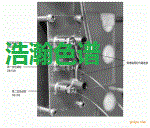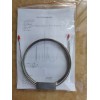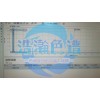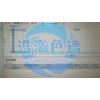ECD is a radioactive ionization detector, which is the use of radioisotopes, in the decay process of radiation with a certain energy of β-particles as the source of ionization, when only the pure carrier of its molecules through the ion source, the β-particle Ionization and ionization into positive ions and free electrons in the role of the applied electric field will do the ion and electrons move, because the electrons move much faster than the positive ions, so the probability of positive ions and electronic recombination is very small, as long as When the carrier gas with a small amount of electronegative components into the ion chamber, the electrophilic components, a large number of electrons to form negative ions or negative charged molecules. (2) the formation of a certain ion current (base flow). Because the negative ions (molecules) and the positive ion is almost the same rate of positive ions and negative ions than the positive ions and electron compound probability of 105 to 108 times higher, and thus the base flow decreased significantly, so the instrument output a negative polarity of the electrical signal, Therefore, in contrast to FID, the output of the measured component by ECD gives a negative peak in data processing.
1. ECD came out in 1961, it and FID, chromatographic temperature analysis called chromatographic development in the three major breakthroughs;
2. It is a high sensitivity, high selectivity detector, sensitive to electronegative substances;
3. The minimum detection amount of up to 10-13 grams (γ -666), the sensitivity of carbon tetrachloride and n-hexane ratio of 4 × 108 times;
4. It is mainly used for the analysis and determination of halides, phosphorus (sulfur) compounds and peroxides, nitro compounds, metal organic compounds, metal chelates, steroids, polycyclic aromatic hydrocarbons and conjugated hydroxy compounds such as electronegative substances. In addition can also analyze 1PPM oxygen;
5. The use of chemical conversion method, it has a strong electronegativity of the derivative and expand the use of electron capture detector range;
6. ECD has become one of the most widely used detectors in the fields of food inspection, pesticide residues in animal (plant) and environment (water, soil, air pollution, etc.).
电子捕获检测器
电子捕获检测器 详细信息:

ECD是放射性离子化检测器的一种,它是利用放射性同位素,在衰变过程中放射的具有一定能量的β-粒子作为电离源,当只有纯载其分子通过离子源时,在β-粒子的轰击下,电离成正离子和自由电子,在所施电场的作用下离子和电子都将做定向移动,因为电子移动的速度比正离子快得多,所以正离子和电子的复合机率很小,只要条件一定就形成了一定的离子流(基流),当载气带有微量的电负性组分进入离子室时,亲电子的组分,大量捕获电子形成负离子或带电负分子。因为负离子(分子)的移动速度和正离子差不多,正负离子的复合机率比正离子和电子的复合几率高105 ~ 108 倍,因而基流明显下降,这样就仪器就输出了一个负性的电信号,因此和FID相反,通过ECD被测组分输出,在数据处理上出负峰。
1. ECD在1961年问世,它与FID、色谱程序升温分析称为色谱仪发展中三大突破;
2. 它是一种高灵敏度、高选择性检测器,对电负性物质特别敏感;
3. zui小检测量可达10-13克( γ —666),对四氯化碳和正己烷灵敏度的比为4×108倍;
4. 它主要用于分析测定卤化物、含磷(硫)化合物以及过氧化物、硝基化合物、金属有机物、金属螯合物、甾族化合物、多环芳烃和共轭羟基化合物等电负性物质。另外也能分析1PPM氧气;
5. 采用化学转化方法,使其具有强电负性的衍生物而扩大电子捕获检测器使用范围;
6. ECD已成为目前在食品检验、动(植物)体中的农药残毒量和环境检测(水、土壤、大气污染等)领域中应用多的一个检测器之一。
电子捕获检测器 图片:











